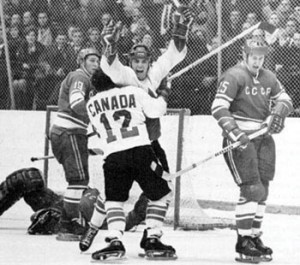Golden Goal or Super Summit?
by Blaine Meller

Photo by Frank Lennon via Flickr. Henderson scored a goal that brought a nation together, but is curiously absent from the Hockey Hall of Fame.
Thirty-eight years ago, legendary broadcaster Foster Hewitt uttered a phrase that, to this day, remains one of the true defining moments in Canadian sports history. “They score! Henderson has scored for Canada!”
It was September 28, 1972. With 34 seconds left in the third period, Paul Henderson beat USSR goaltender Vladislav Tretiak to give Canada a 6-5 lead, stunning the crowd at Luzhniki Ice Palace in Moscow. That goal would hold up, giving Canada not only a game victory, but a 4-3-1 series win as well.
In ’72, the Canadians were being touted as the clear favorites. With a lineup filled with NHL stars, many predicted the locals would have an easy time with their Soviet counterparts. As history will show, that was indeed not the case. Team Canada only captured one of the first four games — all of which were played on Canadian soil — a 4-1 triumph at Maple Leaf Gardens in Toronto. Losses of 7-3 in Montreal and 5-3 in Vancouver, coupled with a 4-4 tie in Winnipeg, meant Canada would head to Moscow facing a 1-2-1 deficit.
After losing Game 5, Canada would win the next two matches, setting up a showdown in the eighth and final contest. Cue Henderson and the defining moment of his career, one he never duplicated.
During his time in the NHL, Henderson played for Detroit, Toronto and Atlanta. In 707 career games, he tallied 241 goals and 477 points, good enough for 423rd place all time. In comparison, Sidney Crosby, who scored the overtime winner in helping Canada to gold at the 2010 Vancouver Olympics, has 183 goals and 506 points in 371 career games to date. The difference? People expected great things of Crosby.
There is a generation of hockey fans (much younger than I, but that’s a subject for another day) who will argue Crosby’s goal was bigger and even more historic, for it allowed this country’s hockey heroes to capture gold on home soil. Fair enough. Most of you will remember where you were when Sid the Kid beat American goalie Ryan Miller.
How many of you reading this remember ’72, or were actually even alive at that time? Even Crosby himself wasn’t born until 1987.
Back in June, a Toronto businessman paid $1.2 million for the No. 19 jersey worn during the ’72 series. Mitch Goldhar, CEO of SmartCentres, announced a contest and initiative to take the jersey on a cross-country tour. The sweater and other artifacts will be shipped in a trailer specially outfitted for the event. As far as I know, there has been no such thing planned for Crosby’s sweater.
There are two injustices that remain surrounding Henderson. First is his exclusion from the Hockey Hall of Fame. Granted, his NHL numbers don’t warrant his inclusion in the hall, but what he did in ’72 surely does. The second injustice relates to nothing Henderson did on the ice. In February, Henderson, now 67, announced he is battling lymphocytic leukemia. While reports have him doing well, it would be a shame to have this man, who scored arguably the biggest goal in Canadian hockey history, unable to witness his enshrinement in the Hockey Hall of Fame. After all, it is the HOCKEY Hall of Fame, not the NHL Hall of Fame. And for what Henderson did for Canadian hockey back in 1972, he deserves his day of recognition.



